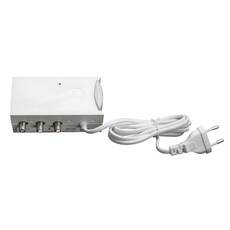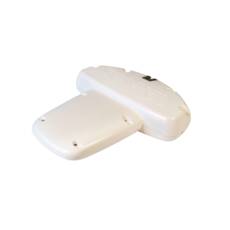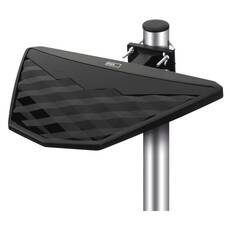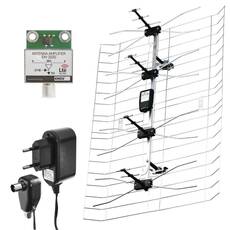Outdoor TV Antenna
As mentioned earlier, TV antennas can be basically divided into two groups, outdoor and indoor. The choice of which one to use depends mainly on the location of the property, its possibilities and the distance to the nearest TV tower. But before we go any further, there are a few questions we should clarify. Why we need an outdoor TV aerial. This type of antenna receives and transmits radio waves to the television. These antennas are placed either on the front of the property or on the roof of the property, depending on whether you want to watch TV inside, i.e. indoors or in the garden. Read more...
• High gain 10 elements outdoor antenna
• With 5G<E filter (It filters out 5G and LTE frequencies that can interfere with over-the-air TV reception if you live near a cell tower)
• UHF 470-697 MHz
• Gain: 13 dB
• Reception range: 21-69 channels (470 - 862 MHz)
• Connectors: waterproof dipole and F connector
• Material: aluminium, plastic
• High gain 27 elements outdoor antenna
• With 5G<E filter (It filters out 5G and LTE frequencies that can interfere with over-the-air TV reception if you live near a cell tower)
• UHF 470-697 MHz
• Gain: 15 dB
• Connectors: waterproof dipole and F connector
• Material: aluminium, plastic
• Version: Outdoor
• Frequency range: 470-790 MHz
• Output RF impedance: 75 Ohm
• Frequency bands: UHF
• Suitable for receiving Full HD broadcasts: Yes
• Version: Outdoor YAGI
• Frequency range: 470-790 MHz
• Output RF impedance: 75 Ohm
• Frequency bands: UHF
• Suitable for receiving Full HD broadcasts: Yes
• Band: UHF
• Channels: 21...48
• Frequency range: UHF470...694 MHz
• LTE protection: @ 700Mhz
• Batteries: 14
• Mounting: bracket - rear
• Main material: aluminium
• Gain: 13,5 max dBi
• Gain at 474 MHz (channel 21): 10.9 dBi
• Rejection @ 788 MHz (channel 60): 8,3 dB
• Front-to-back ratio - horizontal: 23 db
• Reception: DAB/DVB-T/T2
• LTE/4G filter
• Reception angle: 30°/40°
• Frequency bands: VHF/DAB/UHF
• Frequency range: 170-790 MHz
• Connector type: F connector
• Power supply: 12 V/100 mA (included)
• Horizontal and vertical polarization
• Capable of receiving Full HD broadcasts or multiple transmitters
• Built-in low noise amplifier with separate power supply
• RF output impedance: 75 Ohm
• Kit including antenna, preamplifier and power supply
• Recommended installation distance from TV tower 0-100 km
• Dimensions: 178 × 560 × 780 mm
• LTE/4G filter
• Reception: DAB/DVB-T/T2
• Frequency bands: VHF/DAB/UHF
• Frequency range: 170-790 MHz
• Reception angle: 30°/40°
• Horizontal and vertical polarization
• Connector type: F connector
• Suitable for Full HD broadcasts
• Power supply: 12 V/100 mA (included)
• Output RF impedance: 75 Ohm
• Built-in low noise amplifier with separate power supply
• Kit including antenna, preamplifier and power supply
• Recommended installation distance from TV tower 0-100 km (farm)
• Dimensions: 178 × 560 × 780 mm
• Version: Universal
• Filters: 3G, 4G, LTE and 5G
• Frequency range: 47–698 MHz
• Output RF impedance: 75 Ohm
• Frequency bands: FM/VHF/UHF
• Suitable for receiving Full HD broadcasts: Yes
• Max. distance: 80km
• Gain: VHF: 28.0 dB; UHF: 27.0 dB
• Frequency range: FM 87.5-108 MHz; DAB 200-240 MHz; VHF 174-230 MHz; UHF 470-694 MHz
• LTE protection: 700Mhz
• Antenna surface treated to withstand salt water and weather conditions
• Ideal flexible solution for home, indoor, caravan, boat, mobile home, bus and truck
• TETRA safe
• Mounting type: can be attached to a mast bracket
• Dimensions: 45 mm (height) x 325 mm (length) x 255 mm (width) x 255 mm (depth)
• Net weight: 0,390 kg
• 2 inputs, AC + DC 12V
• Automatic switch from 12 VDC to 230V AC input upon availability
• When connected to 230V AC, delivers 24V DC 200mA
• When connected to camping-car 12V DC, delivers 12V DC 200mA
• 1 x RF F-connector input
• 2 x RF auto-terminated F-connector outputs for 2 x TV sets
• Signal insertion loss: 4dB.
• Quick and easy installation
• Install instruction already available on UFO 150/170 box and manual
• Single packed in compact color retail cardboard box.
• For outdoor use
• LTE/4G/5G filter
• Antenna type: without passive amplifier
• Reception: DVB-T/T2
• Frequency bands: UHF
• Frequency range: 470-698 MHz
• Reception angle: 38°/80°
• Horizontal and vertical polarization
• Suitable for Full HD broadcasts
• Connector type: F connector
• Power supply: passive
• Output RF impedance: 75 Ohm
• Recommended installation distance from TV tower0-200 km (long distance)
• Dimensions: 1 150 × 520 × 640 mm
• Version: Outdoor YAGI
• Frequency range: 470-698 MHz
• Filters: LTE, 4G, 5G
• Output RF impedance: 75 Ohm
• Frequency bands: UHF
• Suitable for receiving Full HD broadcasts: Yes
• Version: Outdoor YAGI
• Frequency range: 470-698MHz
• Filters: LTE, 4G, 5G
• Output RF impedance: 75 Ohm
• Frequency bands: UHF
• Suitable for receiving Full HD broadcasts: Yes
• Type: log-per
• Channels: UHF 21-69
• Frequency range: 470-860 MHz
• Impedance: 75Ω
• Polarisation: horizontal / vertical
• Gain: 12 dBi
• VSWR: < 1,7:1
• Especially for receiving terrestrial digital TV broadcast
• Bands: UHF
• Signal reception: DVB-T/T2
• Frequency range: 470-698 Mhz
• Output RF impedance: 75 Ohm
• Channels: 21-48
• Gain: 15 dBi
• F/B ratio: >23
• Wind load (@130Km/h) : 93N
• Wind load (@150Km/h): 128N
• Mast diameter: 20-50mm
• Gross weight: 1700 g
• Frequency range: 470-694 Mhz
• Bands: UHF
• Channels: 24-48
• Gain: 42 dBi (boss mode on)- 17 dBi (boss mode off)
• Noise figure: 1,2 dBi
• Powering: 12-24 V
• Aluminium yagi antenna
• Weight: 2086 g
• Height: 736mm
• Width: 560mm
• Boss system
• Frequency range: 470-694 Mhz
• Bands: UHF
• Gain: 34 dBi (boss mode on) - 4-7 dBi (boss mode off)
• Noise figure: 2,5 dB
• Powering: 12-24 V
• Weight: 1000 g
• Dimensions: 412 mm x 328 mm x 73 mm
• Ultra HD 4K
• BOSS technology
• Frequency range: 54-88 mHz, 88-108 mHz, 174-230mHz, 470-694 Mhz
• Antenna with a 360º reception capability
• Gain: 17 dBi - 25 dBi
• Connectors: 3xF and 1xIEC
• Noise figure: 2,5 dBi
• Powering: 12-24 V
• Weight: 1200 g
• Dimensions: 290 mm x 107 mm x 320 mm
• Ultra HD 4K
• BOSS technology
• LTE ready
• Intelligent/passive mode
• Use: Universal
• 4G, LTE and 5G
• Frequency range: 470-698 MHz
• RF output impedance: 75 Ohm
• Reception: DVB-T/T2
• Frequency bands: VHF/UHF
• Full HD reception: Yes
• Reception range: max. 80km
• Használat: Univerzális
• Szűrők: 4G, LTE és 5G
• Használat: beltéri/kültéri
• Frekvenciatartomány: 87,5–230 MHz, 470–698 MHz
• Kimeneti RF impedancia: 75 Ohm
• Jelvétel: FM/DAB/DVB-T/T2
• Frekvenciasávok: FM/VHF/UHF
• Full HD adások vételére alkalmas: Igen
• Vételi távolság: max. 80km
• Usage: outdoor network
• Antenna type: with active amplifier
• Recommended installation distance: 0 - 100 km from TV tower (Farmhouse)
• Amplifier: built-in low noise amplifier with separate power supply
• Reception: DAB/DVB-T/T2
• Frequency range: 170-790 MHz
• Connector type: F connector
Why choose an outdoor TV antenna?
There are many advantages to using this type of antenna. They provide better reception than their indoor counterparts. They are ideal if you live far from transmission towers or if there are obstacles between them and your property. They can be used to receive local channels and provide better signal quality than indoor TV aerials. What's more, outdoor TV aerials are weatherproof, so you don't have to worry about having to keep changing them. By using them outdoors, they can successfully pick up the signal, giving you perfect picture and sound quality.
What cable to use for outdoor TV aerials?
For outdoor TV antennas, you will mostly need 75 ohm cables. But the length and quality of the antenna cable is also important. Because the longer the cable, the lower its shielding performance. This is expressed in dB, so the higher the value, the better the shielding of the antenna cable. If you don't know which length is right for you, the staff at DND Telecom webshop will be happy to advise you. But for TV aerial and RF cables, you can also choose a pre-assembled version. In addition, care should be taken to choose a cable with the same impedance as the antenna's ground resistance.
For TV antennas, we distinguish between active and passive versions
There are two further types of outdoor antenna: passive antennas are not connected to electricity and not only receive the signal but also amplify it.
What to look out for when buying an outdoor antenna?
Before buying an antenna, there are a few things to consider to ensure good reception: taking these details into account will help you choose the right antenna that will give you the best signal quality and range for your TV. Here are the most important factors to consider. The first and perhaps most important consideration is location and signal strength. Because this will determine which outdoor antenna you choose. If your home is located far away from the TV tower, you should choose a strong outdoor antenna.
Another important question is what channels you want to receive. For conventional channels, choose an antenna that receives VHF and UHF signals. But nowadays you can also choose an outdoor antenna that can receive full-HD broadcasts. Once these details are clarified, we then need to consider whether the antenna will be mounted on the façade or on the roof. We can mount the outdoor antenna ourselves if we don't have a fear of space, but a professional will ensure perfect picture and sound quality. If you still do the installation yourself, be aware of signal interference. Because devices such as microwaves and Wi-Fi routers can interfere with the TV signal.
When buying an outdoor TV aerial, be aware of its range
As mentioned above, when installing an outdoor TV antenna, you need to pay attention to its range. After all, if you choose the wrong antenna to provide a secure connection between your TV and the TV tower, you will either get a poor reception or a picture that is never crystal clear. Determining this requires expertise. DND Telecom's online shop offers outdoor TV antennas that ensure perfect reception from up to 200 km away.
What to look for when installing an outdoor TV antenna
In this case, we need to make decisions such as choosing the right bracket, the exact location of the installation, and whether to install a lightning arrester on the antenna. The exact installation location is also important because the outdoor antenna should be placed at the highest point of the building. However, in this case we need to take the weight of the antenna into account, as this will determine which mast mounting we need to use. If we can only mount the antenna on the façade, we need to determine how far it should be from the wall. These details will largely determine the type, size and finish of accessories you will need to mount the outdoor antenna successfully.






















